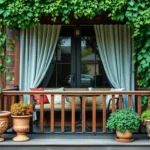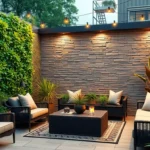The colonial front porch represents one of America’s most enduring architectural traditions – a perfect blend of functionality and timeless elegance that’s captivated homeowners for centuries. These welcoming spaces aren’t just decorative features; they’re carefully designed extensions of our homes that reflect the practical wisdom and refined aesthetics of early American settlers.
We’ve discovered that colonial porches offer something truly special: they create an inviting transition between indoor and outdoor living while maintaining that classic, sophisticated appeal that never goes out of style. Whether you’re restoring a historic home or adding colonial charm to a modern residence, these porches provide the perfect canvas for creating memorable first impressions.
From iconic white columns and traditional railings to period-appropriate lighting and furnishings, we’ll explore the essential elements that make colonial front porches so irresistibly charming. Let’s jump into the design principles and practical ideas that’ll help you create your own slice of American architectural history.
Classic Colonial Front Porch Design Elements
Understanding the fundamental components that define colonial porch architecture helps create an authentic and timeless design. These essential elements work together to establish the distinctive character that makes colonial porches so enduringly popular.
Symmetrical Column Arrangements
Symmetrical column arrangements form the backbone of traditional colonial porch design, creating visual balance and architectural integrity. We recommend spacing columns evenly across the porch width, typically 6 to 8 feet apart for optimal proportions. Classic round columns with simple capitals work best, though square columns can provide a more robust appearance for larger homes.
Pairing columns creates a formal entrance that draws visitors toward the front door naturally. Double columns at corners add structural emphasis while maintaining the symmetrical aesthetic. Fluted columns introduce subtle texture without overwhelming the clean colonial lines we’re aiming to achieve.
Traditional White Painted Railings
Traditional white painted railings complement colonial architecture by providing safety and visual definition without competing with the overall design. We suggest using simple balusters spaced 4 to 6 inches apart to meet modern building codes while preserving period authenticity. Flat top rails create clean horizontal lines that emphasize the porch’s welcoming width.
Spindle style balusters offer classic appeal and work particularly well with turned wooden posts. Simple square balusters provide a more understated look that suits both traditional and transitional colonial styles. Matching the railing color to your column paint creates cohesive visual flow across all porch elements.
Brick or Stone Foundation Features
Brick or stone foundation features anchor colonial porches to the ground while adding substantial visual weight to the overall composition. We prefer red brick foundations that complement white columns and create the classic colonial color palette homeowners recognize instantly. Natural fieldstone foundations work beautifully for rural or country colonial homes seeking a more rustic character.
Raised foundations elevate the porch 2 to 3 feet above ground level, creating the commanding presence that defines colonial architecture. Stone caps along the foundation top provide finished edges and protect against weather damage. Lattice panels between foundation piers allow for ventilation while concealing the space beneath your porch floor.
Traditional Colonial Color Schemes for Front Porches
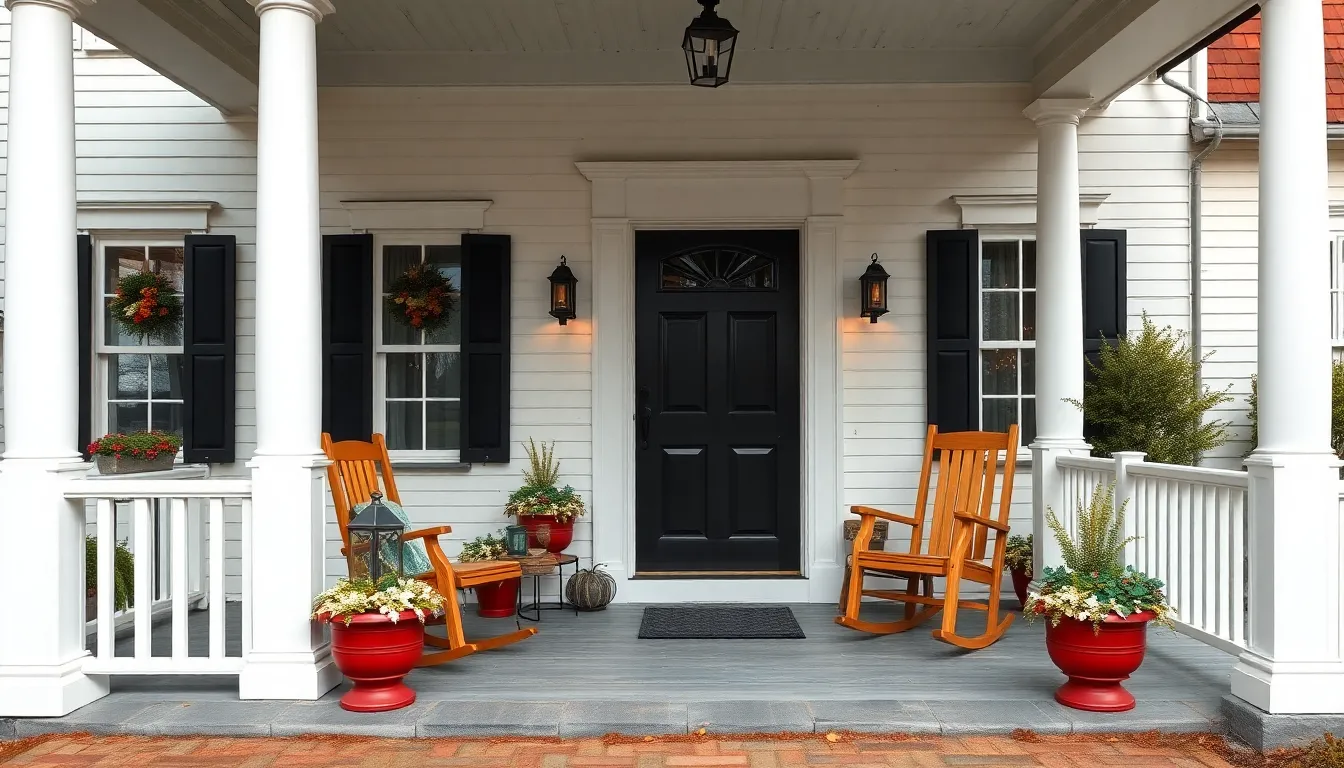
Color choices play a crucial role in achieving an authentic colonial porch aesthetic that complements the architectural foundation elements we’ve discussed.
Classic White and Black Combinations
White and black combinations create the most recognizable colonial porch color scheme that enhances architectural symmetry. We recommend painting trim, columns, and railings in crisp white to provide a fresh canvas that highlights the wood and brick materials typical of colonial homes. Black front doors or shutters add sophisticated depth while creating sharp contrasts against white elements.
This timeless pairing works exceptionally well on farmer’s porches and center entry colonial homes where historical accuracy matters most. White paint complements the clean lines of round or square columns we’ve previously discussed, while black accents draw attention to entryways and window features. The combination maintains the formal colonial design aesthetic while boosting curb appeal through classic contrast.
Historical Paint Colors and Finishes
Authentic colonial paint colors embrace muted, earthy tones inspired by natural pigments available during the 18th century. We suggest incorporating deep red, colonial blue, sage green, and warm tan shades that reflect the period’s color palette. These historically accurate hues work beautifully with the brick foundations and traditional railings that anchor colonial porches.
Matte or satin finishes preserve the authentic colonial look better than glossy options that appeared later in architectural history. Heritage paint lines from traditional manufacturers offer specially formulated colors that replicate colonial era pigments. Front doors painted in contrasting dark red or navy blue create visual interest while honoring period style conventions.
Accent Colors That Complement Colonial Architecture
Strategic accent colors enhance colonial porches without overwhelming the traditional white and cream backgrounds. We recommend incorporating navy blues, muted greens, and deep reds through lantern style lighting fixtures in black or bronze finishes. These colors complement the symmetrical column arrangements and traditional railings that define colonial porch architecture.
Planters and porch furniture in classic colors like deep red, natural wood tones, and white contribute to the authentic colonial atmosphere. Seasonal decorations including wreaths or pillows in traditional colors reinforce the historical feel while maintaining the restrained palette. Natural wood rocking chairs and bronze lanterns add charm while preserving the architectural integrity of colonial front porch designs.
Authentic Colonial Porch Flooring Options
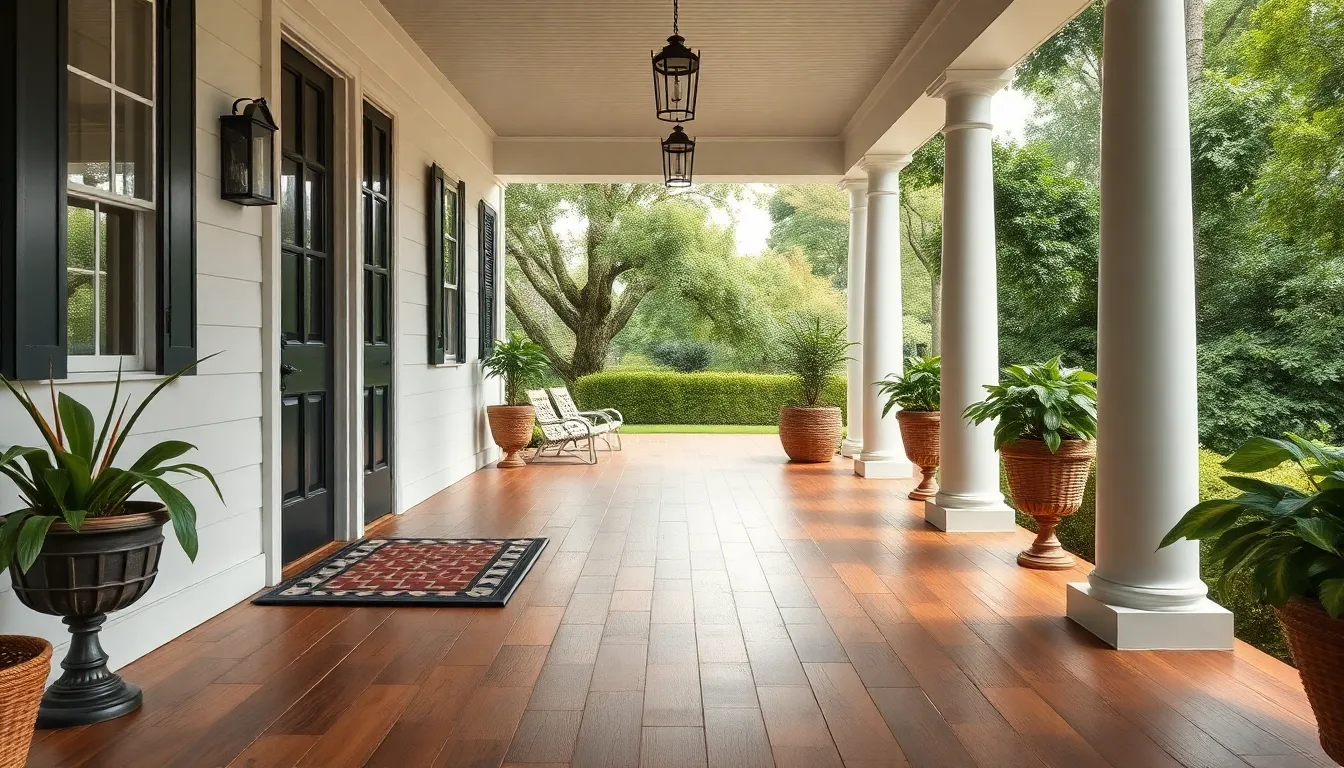
Building on our colonial porch’s structural and visual foundation, we need to select flooring that reflects authentic period craftsmanship. The right flooring choice creates the perfect base for our welcoming colonial entrance.
Wide Plank Wood Decking
Wide plank wood decking serves as the most traditional choice for colonial porch flooring, typically featuring boards made from pine, oak, or cedar. We recommend using planks that mirror early American craftsmanship with their natural warmth and rustic charm. Colonial builders often used locally available softwoods like pine for their affordability and workability.
Modern interpretations can incorporate durable hardwoods like ipe while maintaining the traditional wide board appearance. These contemporary options offer enhanced longevity without sacrificing the authentic colonial aesthetic we’re trying to achieve. Natural wood staining brings out the grain patterns that were prized during the colonial period.
Traditional Stone and Brick Patterns
Stone and brick flooring options reflect the regional materials that colonial builders used throughout different areas of early America. We find that herringbone brick patterns create stunning visual texture while maintaining period authenticity. Red brick laid in traditional patterns handles outdoor weather conditions exceptionally well.
Natural stone slabs provide another authentic option, particularly fieldstone or limestone that would have been locally quarried during colonial times. These materials add a sense of permanence and craftsmanship that complements the overall colonial architecture. Regional availability often determined which materials colonial builders selected for their porch foundations.
Period-Appropriate Painted Floor Designs
Period painted floors offer a practical and decorative approach that colonial homeowners frequently employed to protect their wood surfaces. We suggest using simple geometric patterns or classic stripes in authentic colonial colors like deep reds, colonial blues, and sage greens. These muted, earthy tones reflect the pigments that were readily available during the 18th century.
Painting porch floors served the dual purpose of preservation and ornamentation without requiring expensive materials. This cost effective method allowed colonial families to add visual interest while extending the life of their wooden porch surfaces. Modern reproductions should use matte or satin finishes to maintain the authentic appearance of historic painted floors.
Colonial-Style Porch Furniture and Seating Ideas
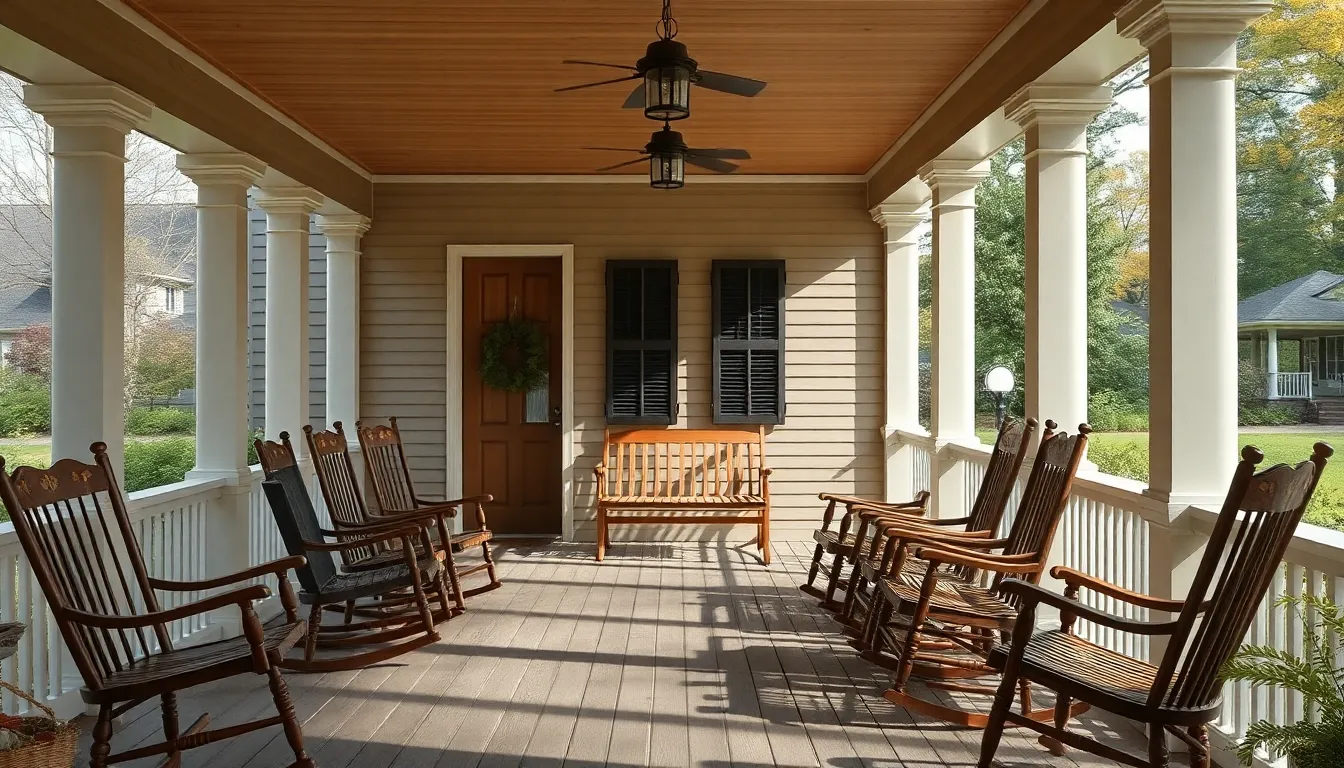
Now that we’ve established the architectural foundation, let’s explore the furniture pieces that complete our colonial porch design. Authentic colonial seating arrangements reflect the simplicity and craftsmanship of 18th-century American life.
Windsor Chairs and Rocking Chair Arrangements
Windsor chairs serve as the cornerstone of colonial porch seating with their distinctive spindle backs and elegant curves. We recommend arranging these classic pieces in pairs or small groupings to create intimate conversation areas that reflect colonial simplicity and comfort. Wooden rocking chairs complement Windsor chairs perfectly, providing a signature element that defines many colonial porches.
Rocking chairs offer a cozy spot to relax and socialize while maintaining the period’s aesthetic appeal. We suggest positioning them at slight angles to encourage conversation and create visual interest across the porch space. Natural wood tones work best for these pieces, though painted finishes in muted colonial colors can add subtle character without overwhelming the traditional design.
Traditional Porch Swings and Gliders
Porch swings enhance both functionality and appeal as period-appropriate additions to colonial porches. These pieces typically feature wooden slats and simple, sturdy designs that provide slow, soothing motion while enjoying the outdoors. We recommend hanging swings from the porch ceiling using traditional chain or rope supports to maintain the authentic colonial aesthetic.
Gliders offer an alternative seating option with their bench-style design that sits directly on the porch floor. Floor-mounted gliders work particularly well for porches with lower ceilings or when ceiling mounting isn’t practical. Both swings and gliders should emphasize natural wood construction with minimal ornamentation to stay true to colonial design principles.
Period-Inspired Benches and Tables
Simple wooden benches provide additional seating while maintaining the colonial porch’s authentic feel. We suggest choosing benches with basic craftsmanship and clean lines that complement the overall design without competing with primary seating pieces. Small tables with turned legs or simple construction work perfectly for displaying period-appropriate decor like lanterns or potted plants.
Natural wood tones remain the preferred choice for these accent pieces, though painted finishes in muted colors can work when they coordinate with the overall color scheme. Tables should be sized appropriately for the porch space, serving as functional surfaces without overwhelming the seating arrangements. These pieces help create a complete colonial porch environment that balances practicality with historical authenticity.
Lighting Solutions for Colonial Front Porches
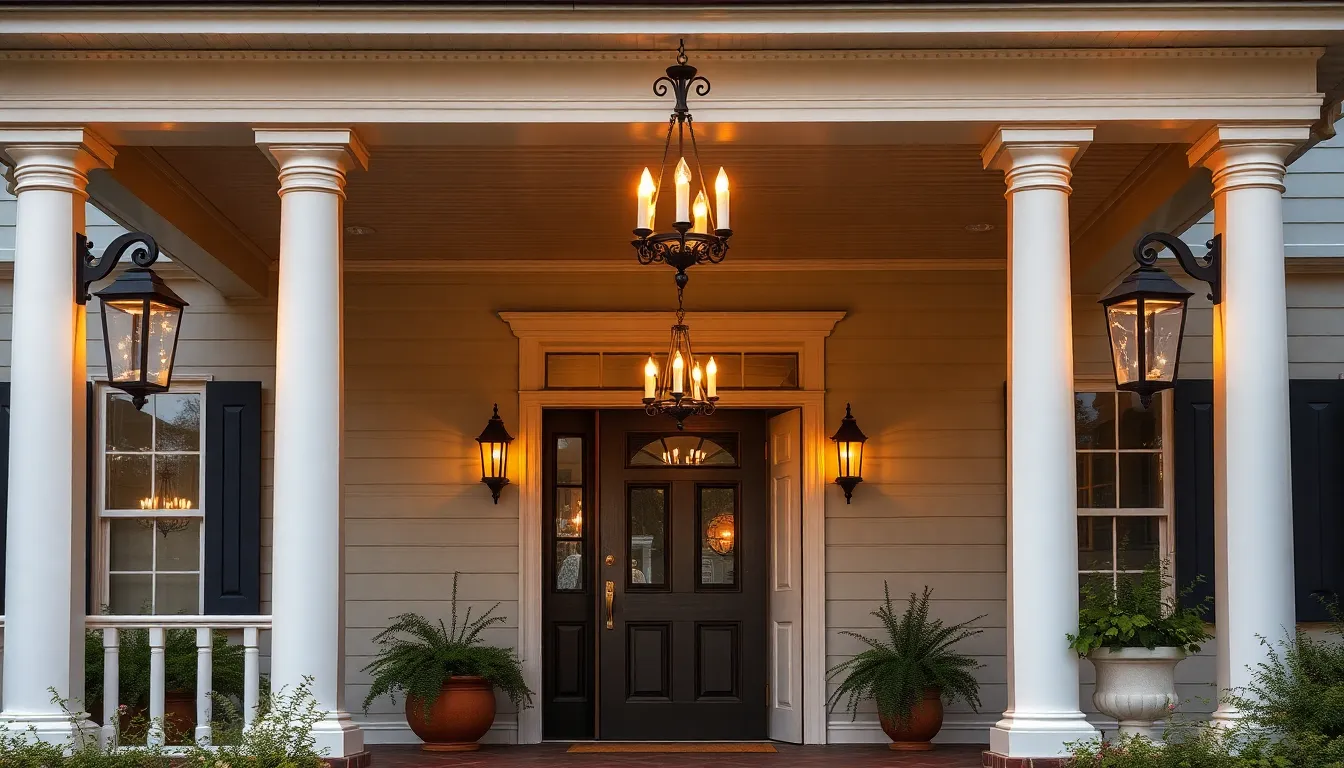
Proper lighting completes our colonial porch design by adding both safety and authentic period charm. We’ll explore traditional fixtures that honor 18th-century aesthetics while providing modern functionality.
Lantern-Style Fixtures and Sconces
Lantern-shaped fixtures serve as the cornerstone of colonial porch lighting, featuring straightforward and stately designs that reflect 17th and 18th-century American architecture. We recommend choosing materials like wrought iron, aged brass, copper, or hand-blown glass to achieve the most authentic appearance. These durable fixtures resist weather while providing a welcoming glow at entryways.
Wall sconces flanking your front door create the perfect symmetrical arrangement that colonial design demands. Classic options like the Livingston 4-Light Convertible Pendant offer a traditional six-sided lantern silhouette with period-appropriate finishes including English bronze and antique brass. We suggest selecting fixtures with clean lines and minimal ornamentation to maintain the modest elegance characteristic of colonial lighting.
Weather resistance becomes crucial for porch installations, so we prioritize fixtures with protective coatings and sealed electrical components. Quality lantern-style sconces combine historical accuracy with modern durability, ensuring your colonial lighting withstands seasonal changes while maintaining its authentic appeal.
Candle-Inspired Lighting Elements
Candelabra-inspired chandeliers and sconces capture the essence of colonial-era illumination while offering safer electric alternatives. These fixtures mimic the gentle flicker of candle flames through carefully designed electric bulbs, preserving the historic ambiance our colonial porches require. We recommend selecting pieces with multiple arms or tiers to create the layered lighting effect that candles once provided.
Electric candle-style bulbs in warm color temperatures (2700K-3000K) replicate the soft glow of actual flames without the safety concerns. This approach allows us to maintain the modest elegance of the colonial period while incorporating modern electrical safety standards. Wrought iron or aged metal finishes enhance the authentic appearance of these candle-inspired elements.
Chandelier installations work particularly well on covered porches with adequate ceiling height, while smaller candle-style sconces complement doorways and seating areas. We ensure these fixtures coordinate with our other colonial lighting elements to create a cohesive design throughout the porch space.
Strategic Placement for Safety and Ambiance
Effective colonial porch lighting requires careful positioning near doorways, steps, and along ceiling lines to maximize both safety and visual appeal. We place lantern sconces at eye level flanking the front door to create welcoming symmetry while ensuring adequate illumination for key access. Additional fixtures along porch ceilings softly highlight architectural details without overwhelming the space.
Step lighting becomes essential for multi-level porches, where we install low-profile fixtures that maintain colonial aesthetics while preventing hazards. Pathway lighting extends from the porch to walkways, using smaller lantern-style fixtures that echo the main porch lighting design. This layered approach creates depth and guides visitors safely to the entrance.
We balance ambient lighting with task-exact illumination by combining overhead fixtures with wall-mounted sconces. This strategy ensures adequate visibility for evening activities while maintaining the warm, inviting atmosphere that defines colonial porch design. Energy-efficient LED bulbs in warm tones provide modern functionality without compromising the historic character we’re creating.
Decorative Accents and Colonial Porch Accessories
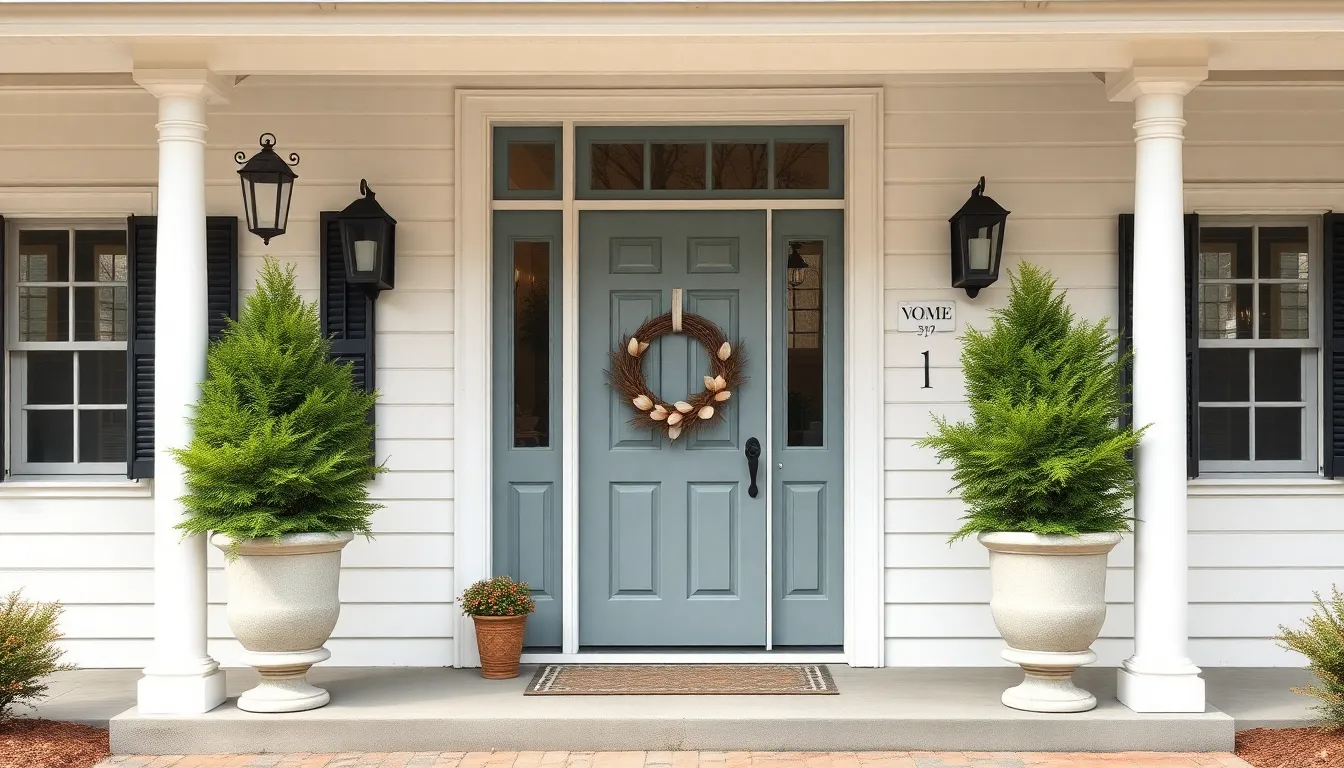
Adding authentic decorative elements transforms a colonial front porch from simple structure to welcoming entrance. These carefully chosen accessories enhance the historical charm while maintaining the clean, understated elegance that defines colonial design.
Seasonal Wreaths and Door Decorations
Natural materials form the foundation of colonial door decorations throughout the year. Wreaths crafted from twigs, magnolia leaves, and seasonal flowers create elegant focal points that complement the typically muted colonial color palettes. Simple designs emphasize texture over elaborate ornamentation, staying true to the period’s preference for restrained beauty.
Door decorations remain minimal yet impactful in colonial styling. Faux ferns provide fresh greenery during spring and summer months without requiring constant maintenance. Natural colors and textures take precedence over bright, artificial elements that would clash with the historical aesthetic.
Seasonal transitions offer opportunities to refresh porch decorations while maintaining authenticity. Summer arrangements might feature dried hydrangeas or simple herb bundles, while autumn calls for corn husks or dried wheat sheaves. Winter decorations focus on evergreen boughs and natural pinecones rather than flashy commercial ornaments.
Traditional Planters and Garden Elements
Classic urn shapes define colonial planter styling near entrance areas and porch steps. Wooden boxes painted in traditional colonial colors like white, navy, or black provide versatile options that coordinate with existing architectural elements. These containers support the colonial emphasis on symmetry and formal garden arrangements.
Boxwoods serve as excellent foundation plantings for colonial porches due to their neat, controllable growth patterns. Ferns add texture and softness to shaded porch areas while maintaining the restrained color palette. Seasonal blooms should complement rather than compete with the home’s architectural features.
Garden elements follow orderly, symmetrical arrangements that reflect colonial preferences for neatness and harmony. Matching planters flanking doorways create visual balance, while herb gardens in wooden boxes add both beauty and functionality. Plants remain well maintained and structured rather than wild or overgrown.
Historic-Inspired Hardware and Details
Wrought iron fixtures provide authentic colonial character through door knockers, hinges, and handles designed to mimic 18th-century craftsmanship. Brass alternatives offer warm tones that complement painted wood trim and enhance the overall historical feel. These hardware elements create tangible connections to colonial America’s functional design principles.
Painted wood trim showcases the colonial attention to architectural detail and craftsmanship. Exposed wood beams add structural interest while maintaining period authenticity. Turned wooden columns and posts demonstrate the skilled woodworking that characterized colonial construction methods.
Traditional lantern-style lighting fixtures complete the colonial porch accessory collection with their historically accurate forms. Flag poles positioned at porch columns allow for seasonal flag displays that personalize the space while respecting colonial aesthetics. These elements work together to create cohesive design that honors the past while serving modern needs.
Landscaping Ideas to Complement Colonial Porches

Thoughtful landscaping enhances your colonial porch’s architectural beauty while maintaining the formal symmetry that defines this timeless style. We’ll explore essential planting strategies and design elements that create an authentic colonial industry around your front porch.
Foundation Plantings and Flower Boxes
Foundation plantings anchor your colonial porch to the surrounding industry through carefully planned symmetrical arrangements. We recommend placing matching shrubs like boxwoods, hydrangeas, or azaleas on either side of your porch steps to create visual balance. These classic plantings should mirror each other in size and spacing to maintain the formal aesthetic colonial homes demand.
Flower boxes attached to porch railings or positioned beneath windows add seasonal color while respecting traditional design principles. Fill these containers with petunias, geraniums, or impatiens during growing season to create lush displays that complement your porch’s clean lines. Mount boxes at consistent heights and intervals to preserve the symmetrical appearance that characterizes colonial architecture.
Seasonal rotation keeps your foundation plantings interesting throughout the year without disrupting the formal structure. Replace summer annuals with mums or small evergreens during fall months, then transition to winter greenery or bare arrangements that showcase the architectural bones of your industry design.
Formal Garden Elements and Pathways
Structured walkways leading to your colonial porch reinforce the geometric, balanced aesthetic this architectural style demands. We suggest using brick, stone, or flagstone pavers rather than modern cement to create pathways that respect historical building materials. These natural materials develop character over time while maintaining their structural integrity.
Line your pathways with low hedges or perennial borders to guide visitors elegantly toward your porch entrance. Box hedges trimmed to uniform heights create crisp edges that complement colonial architecture’s emphasis on order and precision. Alternatively, plant perennial borders with consistent spacing between varieties to achieve the same formal effect.
Stone or brick retaining walls provide both structure and function while serving as raised beds for ornamental or herb gardens. Build these walls using materials that match your pathway construction to create cohesive design flow from street to porch. Position walls strategically to frame your porch views without blocking sightlines to architectural details.
Tree Placement for Shade and Character
Strategic tree placement adds shade, depth, and character to your colonial landscaping without overwhelming the porch’s architectural presence. Plant medium to large deciduous trees like maples or oaks at appropriate distances from your porch to frame the house facade rather than obscure it. These substantial trees provide cooling shade during summer months while allowing winter sunlight to reach your porch.
Smaller flowering trees such as dogwoods or crabapples introduce seasonal interest and visual softness to balance the formal hardscape elements. Position these accent trees asymmetrically within your overall symmetrical design to create natural focal points that draw attention to your porch entrance. Their spring blooms and fall color changes provide year round visual appeal.
Consider mature tree sizes when planning placement to avoid future conflicts with porch structures or utility lines. Space trees according to their expected canopy spread to maintain proper proportions as your industry matures over time.
Modern Updates for Colonial Front Porch Ideas
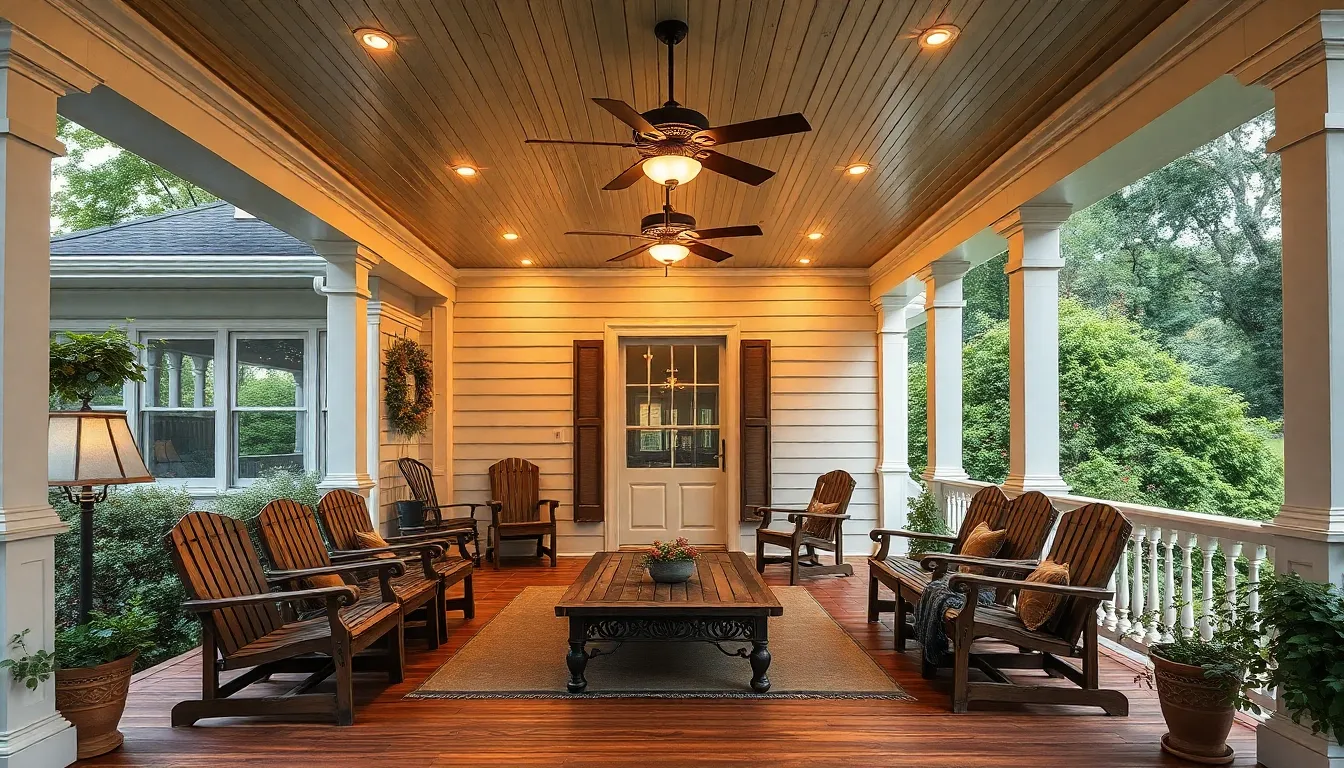
We can honor traditional colonial aesthetics while embracing practical improvements that enhance comfort and functionality. Today’s colonial porch designs seamlessly blend historical charm with contemporary conveniences that make outdoor living more enjoyable.
Incorporating Contemporary Comfort Features
Spacious seating areas transform colonial porches into true outdoor living rooms where families can dine and relax together. We recommend creating designated zones for different activities, such as a dining area with weather resistant tables and a separate conversation space with comfortable seating.
Ceiling fans provide essential air circulation during warm months while maintaining the colonial aesthetic through wood or painted finishes that match existing porch columns and trim. These fans create a more comfortable environment for extended outdoor enjoyment.
Screened sections allow us to enjoy fresh air without dealing with insects or harsh weather conditions. We can incorporate screened areas that preserve the porch’s open feel while creating versatile outdoor rooms that honor colonial traditions of porches as social gathering spaces.
Built in storage answers maintain the clean lines of colonial design while providing practical space for cushions, outdoor accessories, and seasonal items. Benches with hidden storage compartments blend seamlessly with traditional porch furniture arrangements.
Energy-Efficient Lighting and Ceiling Fans
LED lighting fixtures dramatically reduce energy consumption while preserving the traditional colonial aesthetic through classic style sconces and recessed lighting options. We achieve better lighting quality and efficiency without sacrificing the historical appearance that defines colonial porches.
Energy saving ceiling fan motors offer cooling relief during summer months while consuming significantly less electricity than older models. Modern fans with traditional wood or painted finishes complement colonial architecture perfectly.
Smart lighting controls allow us to adjust brightness levels and create ambient lighting scenes that enhance the porch’s evening atmosphere. These systems integrate seamlessly with period appropriate fixtures while providing contemporary convenience.
Solar powered accent lighting provides sustainable illumination for pathways and landscaping features without requiring additional electrical work. We can incorporate these eco friendly options while maintaining the colonial porch’s authentic character.
Weather-Resistant Materials with Traditional Appearance
Pressure treated wood floors with cedar fascia and trim provide the classic wood porch appearance while resisting rot and insect damage better than traditional materials. This approach maintains authenticity while reducing long term maintenance requirements.
Standing seam metal roofs in neutral or burnished slate colors replace traditional shingles for extended lifespan and reduced upkeep. These roofing materials complement colonial styling while offering superior weather protection.
Composite decking and railing materials replicate the appearance of painted wood for porch floors and balustrades while withstanding weather extremes more effectively. We achieve the traditional colonial look with materials engineered for durability.
Timber columns and brick floors combine colonial charm with sturdy, long lasting construction that requires minimal maintenance. These materials create impressive visual impact while standing up to decades of use and weather exposure.
Budget-Friendly Colonial Porch Makeover Tips
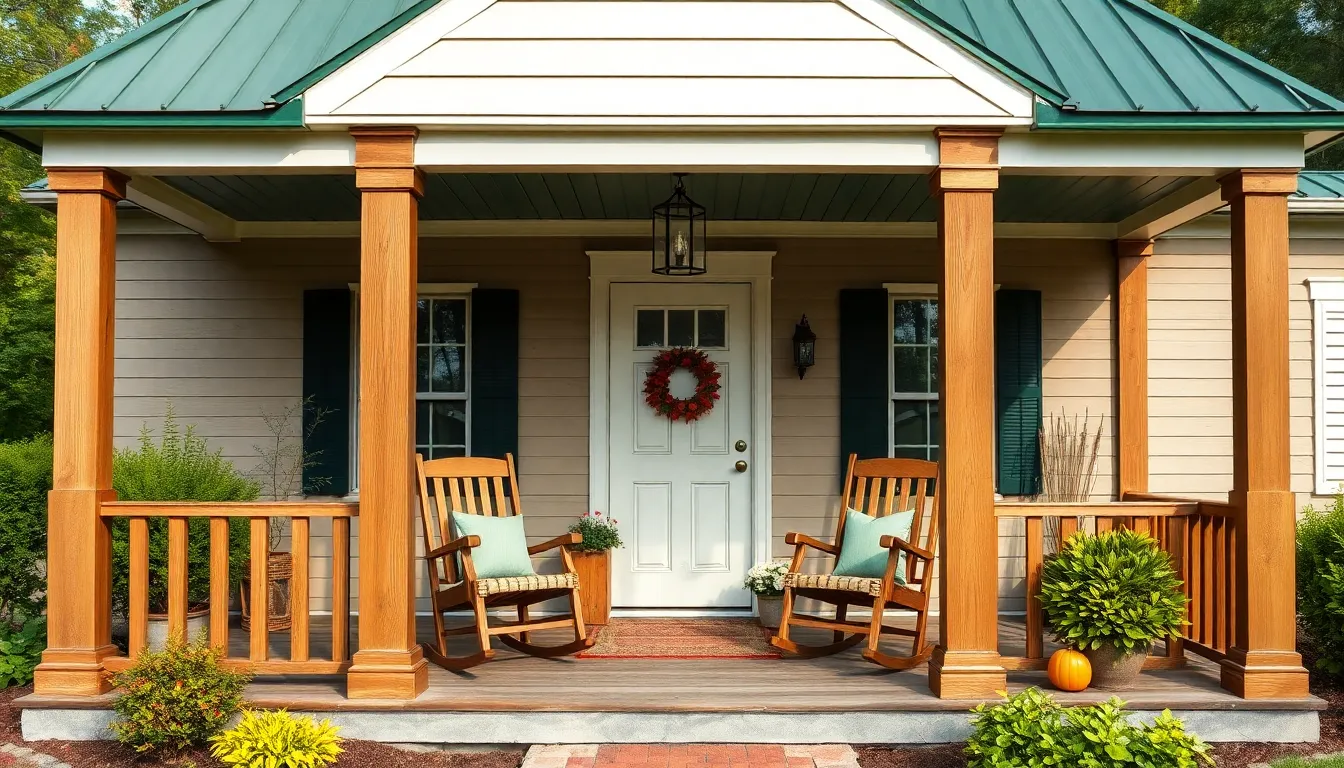
Creating an authentic colonial porch doesn’t require a massive investment. We can achieve stunning results through strategic planning and smart material choices.
DIY Projects for Authentic Colonial Details
Handmade wooden columns transform your porch’s appearance while keeping costs manageable. We recommend starting with pressure treated lumber and classic round or square column designs that reflect 18th-century craftsmanship. Simple woodworking techniques allow us to create fluted details and traditional proportions without hiring professionals.
Custom railings add colonial charm when built using period appropriate baluster spacing and classic designs. We suggest constructing simple rectangular balusters with beveled edges, maintaining the 4-inch spacing rule for safety and authenticity. Pine or cedar lumber works beautifully for these projects and accepts paint well.
Pergola additions create shade and architectural interest using basic construction skills. We can build simple roof extensions over existing entries using treated lumber and traditional joinery techniques. These structures add dimension to flat front walls while providing protection from weather.
Coordinating rocking chair sets complete the colonial look when paired with handmade cushions in period colors. We recommend building simple Windsor-style rockers or refinishing vintage pieces with colonial paint schemes. Adding coordinating pillows in muted colonial blues or sage greens enhances comfort and authenticity.
Affordable Material Alternatives
Composite decking delivers the colonial wood appearance while requiring minimal maintenance compared to traditional hardwoods. We’ve found that composite boards in cedar or weathered gray tones cost significantly less than premium lumber over time. These materials resist rot, insects, and weathering that plague natural wood porches.
Vinyl columns provide weather resistance and colonial styling at a fraction of custom wood costs. We recommend fiberglass alternatives that accept paint well and maintain their shape through temperature changes. These materials eliminate the ongoing maintenance requirements of traditional wood columns.
Paint grade MDF trim offers budget friendly answers for porch details and decorative elements. We use PVC trim boards for areas exposed to moisture, as they resist rot while accepting paint beautifully. These materials allow us to create complex molding profiles without expensive millwork.
Metal roofing in standing seam styles provides durability and period authenticity for covered porches. We suggest painted steel in traditional colors like forest green or burgundy to complement colonial exteriors. These roofs last decades longer than asphalt shingles while maintaining historical appearance.
Phased Renovation Approaches
Phase 1 focuses on immediate visual impact through cleaning, painting, and lighting updates. We start by pressure washing existing surfaces and applying fresh white paint to railings, columns, and trim. Adding lantern style fixtures and seasonal decor creates dramatic improvement for minimal investment.
Phase 2 introduces structural improvements like farmer’s porch additions or small roof extensions. We recommend building modest covered entries that provide weather protection and seating space. These projects significantly boost curb appeal while remaining within reasonable budgets.
Phase 3 upgrades flooring and railings using composite materials or treated lumber. We suggest replacing worn decking boards systematically, starting with the most visible areas near the front door. This approach spreads costs over time while maintaining porch functionality.
Phase 4 completes major renovations including custom columns, expanded decks, and full porch rebuilds. We save these expensive projects for final phases when budgets allow comprehensive improvements. This strategy ensures each phase builds upon previous work while delivering immediate visual benefits.
Conclusion
Creating an authentic colonial front porch that captures the timeless elegance of 18th-century American architecture doesn’t have to be overwhelming or expensive. We’ve shown you how thoughtful design choices – from symmetrical columns and traditional color schemes to period-appropriate furniture and strategic landscaping – can transform any porch into a colonial masterpiece.
The key lies in balancing historical authenticity with modern functionality. Whether you’re working with a generous budget or taking a phased DIY approach we’ve outlined practical answers that honor colonial design principles while meeting today’s comfort standards.
Your colonial porch should reflect both heritage and personal style. By combining these elements thoughtfully you’ll create an inviting entrance that welcomes guests while adding lasting value and curb appeal to your home for generations to come.
Frequently Asked Questions
What are the key design elements of a colonial front porch?
Colonial front porches feature symmetrical column arrangements with evenly spaced round or square columns, traditional white painted railings with period-appropriate balusters, and brick or stone foundations. These elements create visual balance and authentic period charm while maintaining the classic aesthetic that has appealed to homeowners for centuries.
What colors work best for colonial porch design?
Classic white and black combinations are ideal for trim, columns, and railings to create architectural symmetry. Historical paint colors like deep red, colonial blue, sage green, and warm tan reflect the 18th-century palette. Use matte or satin finishes for authenticity, with navy blues and muted greens as accent colors.
What flooring options are most authentic for colonial porches?
Wide plank wood decking using pine, oak, or cedar is the most traditional choice, offering warmth and rustic charm. For durability, consider modern hardwoods like ipe. Traditional stone and brick patterns, such as herringbone brick and natural stone slabs, add authenticity and visual texture to colonial porches.
What type of furniture best suits a colonial porch?
Windsor chairs and rocking chairs reflect 18th-century American craftsmanship and simplicity. Arrange them in pairs or small groupings for conversation areas. Porch swings, gliders, and simple wooden benches enhance the authentic feel. Choose natural wood tones and muted painted finishes that coordinate with the overall design.
How should I light a colonial front porch?
Use traditional lantern-style fixtures and sconces made from wrought iron or aged brass for authenticity. Place wall sconces flanking doorways and use low-profile fixtures for step lighting. Candle-inspired lighting elements that mimic gentle candle flames provide period charm while ensuring modern electrical safety.
What landscaping complements colonial porches?
Create formal symmetry with foundation plantings like boxwoods and hydrangeas arranged symmetrically around the porch. Use structured pathways made from brick or stone, lined with low hedges or perennial borders. Plant medium to large deciduous trees for shade and smaller flowering trees for seasonal interest without overwhelming the structure.
Can I modernize a colonial porch while maintaining authenticity?
Yes, integrate contemporary comforts like spacious seating areas, ceiling fans, and screened sections while honoring traditional aesthetics. Use built-in storage solutions, energy-efficient lighting, and weather-resistant materials like pressure-treated wood and standing seam metal roofs to ensure durability without compromising the colonial look.
How can I create a colonial porch on a budget?
Start with DIY projects like handmade wooden columns and custom railings. Use affordable alternatives such as composite decking and vinyl columns that maintain colonial styling. Implement a phased renovation approach, beginning with immediate visual improvements and gradually adding structural upgrades and major renovations over time.





